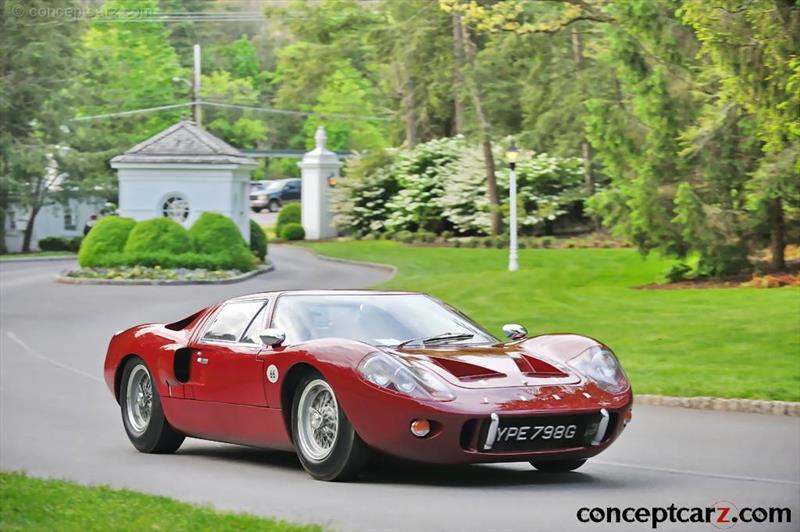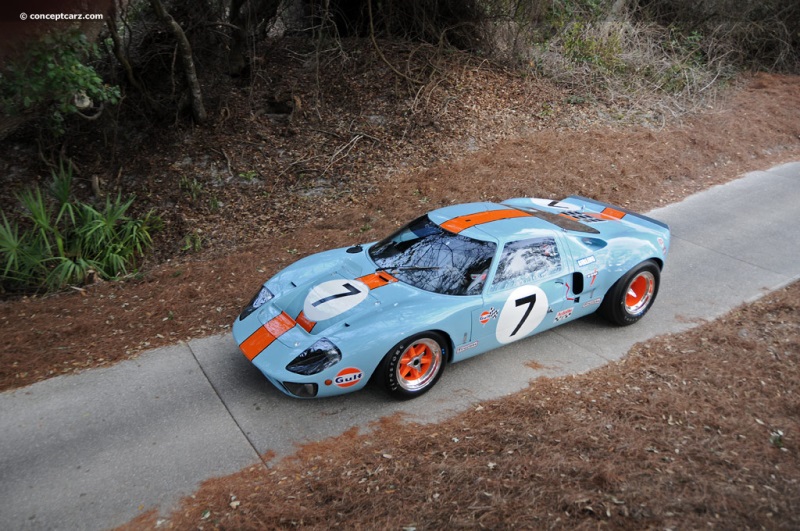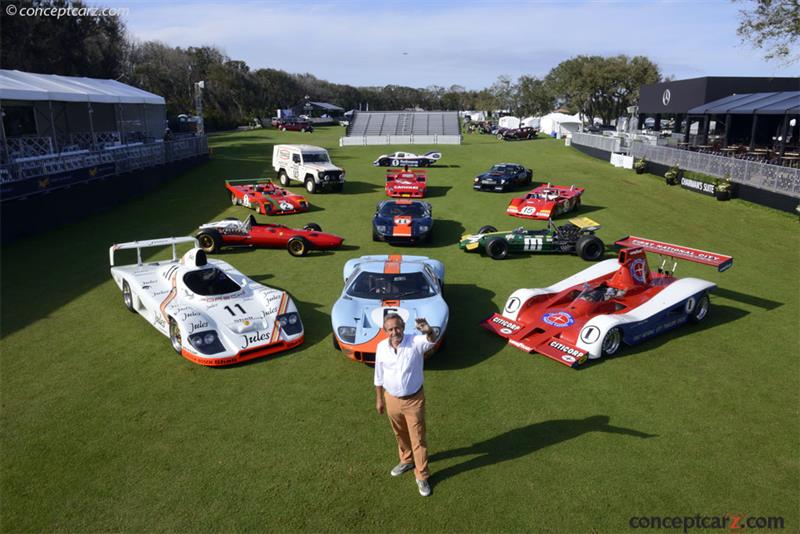During the 1960s, the Ford Motor Company undertook a global promotional advertising campaign called 'Total Performance,' which aimed to succeed in various motorsport competitions, ultimately benefitting their mainstream vehicles and endowing them with similar qualities. 'Win on Sunday, sell on Monday.' This quest led them to race tracks and drag strips around the world, with Ford engines ultimately earning hundreds of victories in NASCAR, CART, Can-Am, Formula One, and many other series. They earned victories at the 12 Hours of Sebring, the 24 Hours of Daytona, in SCCA competition, and rallying. The ultimate achievement were victories at the 24 Hours of Le Mans in 1966, 1967, 1968, and 1969. In 1966 alone, the Ford GT40 finished 1-2-3 against Ferrari, in one of the most memorable photo finishes in the race's distinguished history. 
Competition Coupe
Chassis #: GT40P/1073
View info and history
Auction entries : 1Henry Ford II aggressively pursued a victory at Le Mans after a failed buy-out of Ferrari. Enzo Ferrari had shown interest in selling his company to the Ford Motor Company, and to that end, Ford had spent millions of dollars in an audit of Ferrari factory assents and in legal negotiations. Near the close of negotiations, Enzo left the proceedings due to concerns about his involvement in the race program and being denied the ability to compete at the Indianapolis 500 if the deal went through. Ford used their engines to power Indy cars and did not want to compete with Ferrari. Upon leaving, Enzo challenged Henry Ford II to find a company that could beat Ferrari in world endurance racing competitions.DevelopmentThe gauntlet had been dropped, and just like Ferruccio Lamborghini had been challenged by Enzo to build a better GT car, Mr. Ford began writing blank checks. It would take more than money, however, to beat Ferrari, whose legacy in this level of competition dated back to the 1930s running Alfa Romeo's motorsport program. There was, perhaps, no one who had more experience and knowledge at endurance competition than Mr. Enzo, so Mr. Ford went looking for talent of his own. This path led to Lotus, Cooper, and Lola, with the task ultimately falling upon Lola due to their experience with the Ford V8 engine in its mid-engine Lola MK6 that raced at Le Mans in 1963. Eric Broadley, Lola Cars' owner and chief designer, agreed to the project, albeit without involving Lola Cars. Rather, Mr. Broadley acted as a consultant for a year and sold Ford two Lola MK6 chassis to be built around the Ford engine. John Wyer, a former Aston Martin team manager, was part of the team along with Dearborn engineer Roy Lunn who had designed the mid-engined Mustang I concept car. The team of Wyer, Lunn, and Broadley was overseen by Harley Copp and initially worked out of the Lola Factory in Bromley, moving to Slough, near Heathrow Airport at the end of 1963. Under the direction of Wyer, Ford established Ford Advanced Vehicles (FAV) Ltd to manage the project.
Gulf/Mirage Lightweight
Chassis #: P/1074 (M.10003)
View info and history
Auction entries : 1The first example was chassis number GT/101 and its chassis was built by Abbey Panels of Coventry with the fiberglass moldings constructed by Fibre Glass Engineering Ltd of Farnham. Mounted mid-ship was an aluminum-block 289 cubic-inch (4.7-liter / 4183cc) V8 Fairlane engine with dual overhead camshafts and produced 350 horsepower. It was paired with a Colotti four-speed T.37 transaxle that used half shafts to send power directly to the rear wheels. At both the front and rear were an independent suspension setup masked by the lightweight fiberglass body panels. Chassis numbers GT/101 and GT/102 were the first two prototypes, and 101 was displayed at the New York Motor Show in April of 1964. The first twelve examples were considered prototypes and received serial numbers GT/101 to GT/112. Production began with the MK I followed by the MK II, MKIII, and MK IV and given numbers GT40P/1000 through GT40P/1145. The MK IVs were numbered J1 through J12. Two weeks after the New York show, the team (GT/101 and GT/102) arrived at LeMans for the practice weekend. The GT40's shape had been created with the aid of computers and refined in a wind tunnel, but on the first outings, drivers Jo Schlesser and Roy Salvadori encountered severe rear lifting at high speed that made the cars too dangerous to drive. Both drivers exceeded 190 mph, but only once. On the second day, Schlesser crashed on Mulsanne and Salvadori slid into the bank at the end of the straight. Both drivers were unscathed, but the cars were ruined.
Gulf/Mirage Lightweight
Chassis #: P/1074 (M.10003)
View info and history
Auction entries : 1The three cars that followed, GT/102, GT103, and GT104 continued testing at Motor Industry Research Association (MIRA). GT/101 was comprehensively destroyed but GT/102 was returned for repairs. RacingWith persistence, skillful designers and engineers, talented drivers, and an unlimited budget, the GT40 would earn four consecutive overall Le Mans victories and Ford would win four FIA international titles. They won the Over 2000cc International Manufacturers Championship in 1966, the Division III (Over 2000cc) International Championship for Sports Cars in 1966 and 1967, and the International Championship for Makes in 1968.
Gulf/Mirage Lightweight
Chassis #: P/1074 (M.10003)
View info and history
Auction entries : 1The mid-engine Ford GT40 made its racing debut in May of 1964 at the Nürburgring 1000 km race (the seventh round of the 1964 World Sportscar Championship) where it failed to finish due to suspension failure. The car driven by Phil Hill and Bruce McLaren had shown tremendous potential throughout the race, holding second place before it was force to retire before the checkered flag dropped. The 24 Hours of LeMans was three weeks away, which gave the team time to resolve the suspension issue and make adjustments as needed. Reliability is always a factor during endurance races and teething problems were expected and often only identified under grueling conditions. The same was true for the car's handling issues when at top speed (the 865 kg Ford GT40 had a top speed of 207 mph). The vehicle's tendency to lift at high speed was remedied by forward ground effects, for which the spoiler additionally decreased drag.1964 24 Hours of LeMansThe Ford GT40's first appearance at Le Mans was in 1964 and once again it proved to be tremendously quick, with the car (chassis GT/103) driven by Richie Ginther and Masten Gregory led the field from the second lap until its first pitstop. Two other Ford GT40's had been entered, with Phil Hill and Bruce McLaren driving GT/102 and Richard Attwood and Jo Schlesser in chassis GT/104. GT/103 had qualified in second place behind John Surtees and Lorenzo Bandini in a Ferrari 330P. 
Gulf/Mirage Lightweight
Chassis #: P/1074 (M.10003)
View info and history
Auction entries : 1All three of the Ford GT40s had retired before the mid-way point of the race. The car driven by Attwood/Schessler retired due to a fire, while the other two cars retired due to mechanical issues (engine and gearbox). Further issues plagued the team, leading to a decision to move the racing program from England to the United States. After the 1964 Nassau race and a season of disappointing results, Carroll Shelby was given control of the program and Roy Lunn oversaw the engineering. Shelby's development driver, Ken Miles, was instrumental in transforming the GT40 into a champion. Development was handled by Kar Kraft in the United States and Ford Advanced Vehicles in the UK.Initial revisions by Shelby American, Inc. included improvements to the faulty air ducts, suspension updates, the addition of a high-water-pressure input system, and reworking of the Colotti transmission. The Borrani wheels were replaced by Halibrand alloy wheels. 
Competition Coupe
Chassis #: P/1075
View info and historyKen Miles and Lloyd Ruby drove the GT40 (GT/103) on its maiden outing and its first victory under the Shelby American banner in February of 1965, at the Daytona 2000km Continental. The second car, GT/104 driven by Richie Ginther and Bob Durant, had set the pace for the Shelby team during qualifying. During the race, Bondurant had a minor spin on the first lap and a second driver by Bondurant left him at the back of the field. As the hours ticked by, GT/104 eventually found itself in the lead, but during a scheduled driver change, it was unable to restart due to a condenser issue. The problem took 27 minutes to resolve and when it did return, it was well out of the lead. At the end of the race, GT/104 was in 3rd place, winning 2nd in Class. The following month, Ken Miles and Bruce McLaren placed second overall and first in the prototype class at the 12 Hours of Sebring (in GT/103). GT/104 retired due to rear suspension failure. Bruce McLaren and Ken Miles placed 3rd at Monza. These were the highlights of the season, as further teething problems and disappointments followed the team throughout the season. 1965 24 Hours of LeMans
Coupe
Chassis #: 1103
View info and historySix GT40s contested the 1965 LeMans, with the FAV entry using Alan Mann Racing and drivers Innes Ireland / John Whitmore. This car retired on lap 72 due to a head gasket, finishing six hours of the race. Shelby American supported the Rob Walker Racing Team with drivers Maglioli/Bondurant. They retired on lap 29 due to head gasket issues, finishing 3 hours of the race. Shelby American also supported the Swiss Scuderia Filipinetti team with drivers Müller/Bucknum who also retired on lap 29 due to head gasket issues. Ford France entered an open-top spyder variant for Maurice Trintignant/Guy Ligier who made it eleven laps (2 hours) before retiring due to a gearbox issue.The final two GT40s were under the Shelby-American Inc. banner, with the car driven by Phil Hill and Chris Amon (a Ford GT40X) posting the fastest lap during practice and during the race. It reached a speed of 141.37 mph during practice and 138.44 mph during the race. Unfortunately, it retired on lap 89 (7 hours) due to a clutch issue. The car driven by Ken Miles and Bruce McLaren lasted 4 hours and 45 laps before an issue with the gearbox ended its race prematurely.The Shelby-American team used 7-liter, 450-horsepower NASCAR racing engines based on a Ford Galaxie block. The cars driven by Whitmore/Ireland and Bondurant /Maglioli used a 4.7-liter V8, and the Muller/Bucknum car had a 5.3-liter V8. All engines, except for the Filipinetti entry which used the Colotti gearbox, were paired a ZF gearbox.
Gulf/Mirage Lightweight
Chassis #: P/1074 (M.10003)
View info and history
Auction entries : 1The 1966 Season1966 was the first year Daytona was run in the 24 Hour format, and a trio of 7-liter Mk II dominated the race, placing 1st, 2nd, and 3rd. The following month, in March, the GT40s once again took the top three finishes at the 12 Hours of Sebring, with the X-1 Roadster in first, an MK II in second, and an MK I in third. The 1966 24 Hours of Le Mans
Competition Coupe
Chassis #: P/1075
View info and historyThe number 1 car driven by Ken Miles and Denny Hulme had a four-lap lead over the number 2 car of Bruce McLaren and Chris Amon until they were forced to replace the brake rotors, following an incorrect set being fitted on the previous lap. It was later discovered that the correct brake rotors had been taken by the No.2 crew. As a result, the No2 car gained ground on the No1 car. As the race wore on, Ford management had the decision of dictating the finishing order of the three cars, or having the outcome settled by the drivers. Had the drivers battled against each other, it would have put the multi-million project at risk of success, increasing the chance of mechanical issues or crashing. Minimizing risk and favoring a better photographic outcome, Ford management informed Shelby to instruct the drivers to cross the line side by side. Just before the finish, the Automobile Club de l'Ouest (ACO), organizers of the Le Man's event, informed Ford that the geographical difference in starting positions would be taken into account at a close finish. This meant the McLaren/Amon vehicle, which had started around 60 feet behind the Hulme-Miles car, had covered slightly more distance over the 24 hours, and in the event of a tie, they would be the winner. Rather than reward Miles with the victory (who had been faithful and instrumental in the success with the GT40 program), Ford decided in favor of the photo finish, and gave the victory to McLaren/Amon. Tragically, Miles died two months later while testing the J-car, which later became the Mk VI, at Riverside Raceway. The accident was attributed to the unproven aerodynamics and experimental chassis of the Ford 'J-Car.' 
Competition Coupe
Chassis #: 1076
View info and historyThe prototype development racer was dubbed the J-Car in honor of the new FIA regulations (termed Appendix J to the International Sporting Code). Kar Kraft of Michigan had been commissioned to revise the model. The Brunswick Aircraft Corporation was contracted to provide honeycomb-aluminum paneling for racing tubs, which would later evolve and be adopted as a mainstay in motorsports technology. The sharply tapered front glass at the sides was done in accordance with windshield-width minimums, which aided in aerodynamics but left a relatively narrow cockpit. Adjustments that eventually followed included a more rounded nose and reshaping of the radiator exhaust vent. A total of 12 MK IV chassis were built with the first four wearing the early J-Car bodywork. Two of these cars were subsequently destroyed in accidents occurring during testing. The next four chassis were built with the officially updated Mk IV bodywork and raced at Le Mans and other venues during 1967. Four additional chassis were built but were unable to compete after new engine displacement sizes were introduced for 1968. The final two chassis (J-11 and J-12) were completed during the 1980s. J-9 and J-10 were sold to privateers for use in the Can-Am Series. 1967 SeasonFresh off the embarrassing loss to Ford, Ferrari handily won the Daytona race with an equally impressive 1-2-3 finish. Mario Andretti and Bruce McLaren drove the new MK IV to victory at the next round at Sebring. Ford had also entered three MK IIBs (lightweight versions of the previous year's car) entrusted to Ford France, Holman & Moody (Jo Schlesser/Guy Ligier), and Shelby American (Ronnie Bucknum/Paul Hawkins).1967 LeMans 24 HoursThe 1967 Le Man's race was contested by four Mark IVs, three Mark IIs, and three Mark Is. The MK IV holds the distinction of being the only car designed and built entirely in the United States to achieve an overall victory at Le Mans. The chassis of the Mark IV was new and designed and built in the United States. Its 427 cubic-inch Ford Galaxie-derived engine from the MK II developed 530 horsepower. The LeMans' winning car was piloted by Dan Gurney and A.J. Foyt after leading from the second hour. Ferrari placed second and third.The Ford MK IIB (of Ford Motor Company / Shelby-American) driven by Ronnie Bucknum / Paul Hawkins finished 271 laps before it retired due to valve issues. The MK IV (team Ford Motor Company and Holman & Moody) driven by Mario Andretti and Lucien Bianchi retired after an accident on the 188th lap. The Ford France MK IIB driven by Jo Schlesser and Guy Ligier crashed on lap 183. Roger McCluskey and Frank Gardner (Holman & Moody) crashed their MK IIB on lap 179. Head gasket issues sidelined the GT40 of Ford France (Pierre Dumay/Henri Greder) on lap 129 and the GT40 of Scuderia Filipinetti (Umberto Maglioli/Mario Casoni) on lap 116. The MK IV of Denny Hulme and Lloyd Ruby (Holman & Moody) crashed on lap 86, 8 hours into the race. The GT40 of JW Automotive Engineering driven by Mike Salmon and Brian Redman retired on lap 20 due to a fire. 1968 SeasonRacing regulations for the 1968 season were introduced to limit the high speeds achieved during the previous season. Similar to Formula One rules, the Group 6 Prototypes were limited to a capacity of 3.0 liters (120-liter fuel tank), which meant the V12-powered Ferrari 330P, Chaparral, Mirage, Lola-Aston Martin, and the MK IV were obsolete. A displacement size of 5.0-liters was allowed if at least fifty cars were built. Group 4 Sports were given a limit of 5-liters and a 160-liter fuel tank. Group 3 GTs had no engine limit.In protest, Enzo Ferrari canceled his Prototype program fearing that a 3-liter Prototype would be unable to compete with a 5-liter Sports Car. Only the big manufacturers were capable of producing the minimum 50 cars to qualify for Group 4 homologation, leaving the smaller manufacturers at a disadvantage. 1968 24 Hours of LeMansDespite the absence of many major teams, 58 cars arrived to qualify for the 54 starting positions. Porsche had the most significant number of entries with 13 cars, followed by 11 from Alpine. The Ford factory teams had also withdrawn from the race, and J.W. Automotive had acquired the rights to race the GT40 and purchased the Ford Advanced Vehicles facility at Slough. With sponsorship from Gulf Oil, the J.W. Automotive entries wore a unique light blue and orange livery. Two new cars were been built, and a previous year's Mirages was converted to a GT40, and all were powered by a 5.0-liter V8s developing approximately 415 horsepower. Several of the Mirage's improvements were integrated into the other GT40s, with additional efforts made to reduce the overall weight, including the use of high-tech and exotic materials. Much of the bodywork was comprised of a thin polyester sheet reinforced with carbon fiber. With many of the major competitors absent from the race, and with sophisticated machines, the J.W. Automotive team was poised for victory. However, their two best drivers (Jacky Ickx and Brian Redman) were absent, as they both were suffering from injuries sustained during Formula 1 accent. In their place, were Alfa Romeo team driver Lucien Bianchi and former Ferrari driver Pedro Rodriguez. The team's other drivers included Paul Hawkins and David Hobbs - race winners at Monza - driving their regular car and Brian Muir and Jackie Olver in a new chassis. Claude Dubois entered a GT40 for driver Willy Mairesse / 'Beurlys' Jean Blaton and Mike Salmon and Eric Liddell drove the GT40 entered by Strathaven Ltd. Sadly, Willy Mairesse and Mauro Bianchi would have career-ending injuries at this race. Mairesse crashed on the opening lap while trying to properly secure the door of his car while at speed on the Mulsanne Straight. when the checkered flag dropped, the race had been won (by five laps) by Pedro Rodriguez and Lucien Bianchi, in the J.W. Automotive Gulf-Oil Ford GT40, which earned Ford the manufacturer's title. 1969 Le Mans 24 HoursThe 1969 LeMans race was the final hurrah for the GT40s, ending their four-year-long dominance. Additionally, it was the final year for the traditional 'Le Mans' style start, in which the driver raced across the track to enter their cars, start them, and race away. This style of staring had become controversial, due in part to the career-ending injury of Mairesse the previous year. In protest, eventual winner Jacky Ickx walked to his car and carefully secured his belts, losing valuable time in the process. Driver John Woolfe flipped his car on the opening lap near Maison Blanche corner. His car broke apart and since he was not properly strapped and buckled, was killed instantly. The cars favored to win the race were those from the German manufacturer Porsche, which had already secured the World Sportscar Championship. Over one-third of the cars entered were Porsches, and the 917 was clearly the fastest, having led for 90-percent of the race. It was only after the gearbox of the leading Porsche broke (driven by Elford and Attwood) that the Ford driven by Ickx and Jackie Oliver was able to secure the lead. It was not an easy victory as they were closely pursued by the Porsche 908 of Hans Herrmann and Gérard Larrousse. Ickx crossed the finish line first, just 120 meters ahead of the Porsche, in the same chassis that had won the previous year. The Ford GT40 Road-Going and Race VersionsApproximately 133 GT40s of all variations were built, and 31 of the 87 GT40 P cars were equipped as road cars.The MK I
The earliest prototypes were powered by a 255 cubic-inch all-alloy V8 engine with the production models receiving 289 CID V8s. Most were built as Coupes, and five prototypes received roadster bodywork, including the Ford X-1. AMGT40/1 and AMGT40/2 were built in 1966 by Alan Mann Racing with lightweight alloy bodies. Most examples of the MKI used the ZF five-speed gearbox. The Slough factory produced 31 examples of the MK I for 'road' use. They were very similar to the racing versions but received wire wheels, a cigarette lighter, carpeting, and fabric map pockets in the door. The X-1 Roadster
The X-1 roadster received an aluminum chassis built at Abbey Panels and a 289 cubic-inch engine. It was later upgraded to MK II specifications with a 427 cubic-inch engine. The X-1 received several gearboxes during its existence, including a Hewland LG500. It was built to race in the 1965 North American Pro Series and entered by Bruce McLaren's team for driver Chris Amon, and later won the 12 Hours of Sebring in 1966. Since the X-1 was built in the United Kingdom, it was liable for tariffs in the United States. Thus, United States customs officials later ordered that it be destroyed.The MK II
The MKII was designed to accommodate the 7.0-liter FE (427 cubic-inch) engine from the Ford Galaxie. Its chassis was similar to the MKI, but modified by Homan & Moody in California to house and handle the larger, heavier and more potent powerplant. It was paired with a new Kar Kraft-built four-speed gearbox. The MK III
The MK III was a road-going car fitted with four headlamps, a detuned 4.7-liter engine offering just over 300 horsepower, and the steering wheel could be installed on the left side. The shift lever was moved to the center, an ashtray was added, and the shock absorbers were softened. Four examples were built with left-hand drive configuration and three with right-hand drive. Most customers seeking a Ford GT40 purchased a MK I that was available from Wyer Ltd, since the bodywork of the MK III was significantly different from the racing models. The J-CarThe J-car was was ultimately a new vehicle designed by Ford's studios and produced by Ford's subsidiary Kar-Kraft under Ed Hull. Its lightweight 'tub' was formed of aluminum honeycomb panels bonded together and built in collaboration with the Brunswick Aircraft Corporation. The overall weight of 2,600 pounds was 300 pounds less than the MK II, thanks in part to its tub which weighed a mere 86 pounds. The chassis, in theory, was rigid, but during a test at Riverside International Raceway in August of 1966 with Ken Miles driving, it shattered upon impact. The accident and the ensuing fire claimed the life of Miles. The cause of the accident was blamed on the vehicle's aerodynamics and a lack of a spoiler. Subsequent development of the J-Car, specifically with more aerodynamic bodywork, resulted in the creation of the MK IV. Of the nine J-car chassis built, six were designed as Mk IVs and one as the G7A. The Mk IV (a.k.a Ford MK IV)
While the MK I through MK III cars were built in England, the MK IVs were constructed in the United States by Kar Kraft. Their chassis was a reinforced version of the J-car and equipped with the same 7.0-liter engine as the MK II. A NASCAR-style steel-tube roll cage was installed for safety purposes but its additional weight negated most of the weight-saving features of the honeycomb-panel construction. Although these were completely different from other GT40s, they did incorporate some of the same mechanical components including the brakes, gearbox, and suspension. A two-speed automatic gearbox was tested but later exchanged with a four-speed from the MK II. The streamlined bodywork helped it achieve 212 mph on the Mulsanne Straight.The Ford GT40 holds the distinction of being Dearborn's first and most important purpose-built sports-racing model, achieving four consecutive wins at the 24 Hours of Le Mans.
by Daniel Vaughan | May 2022
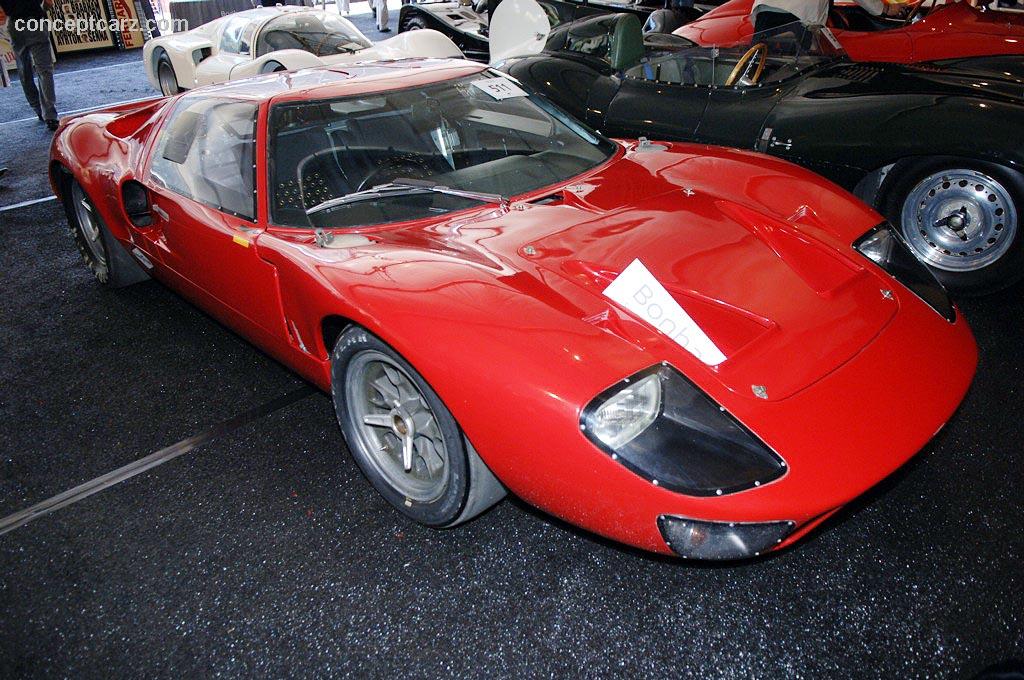
Competition Coupe
Chassis #: GT40P/1073
View info and history
Auction entries : 1
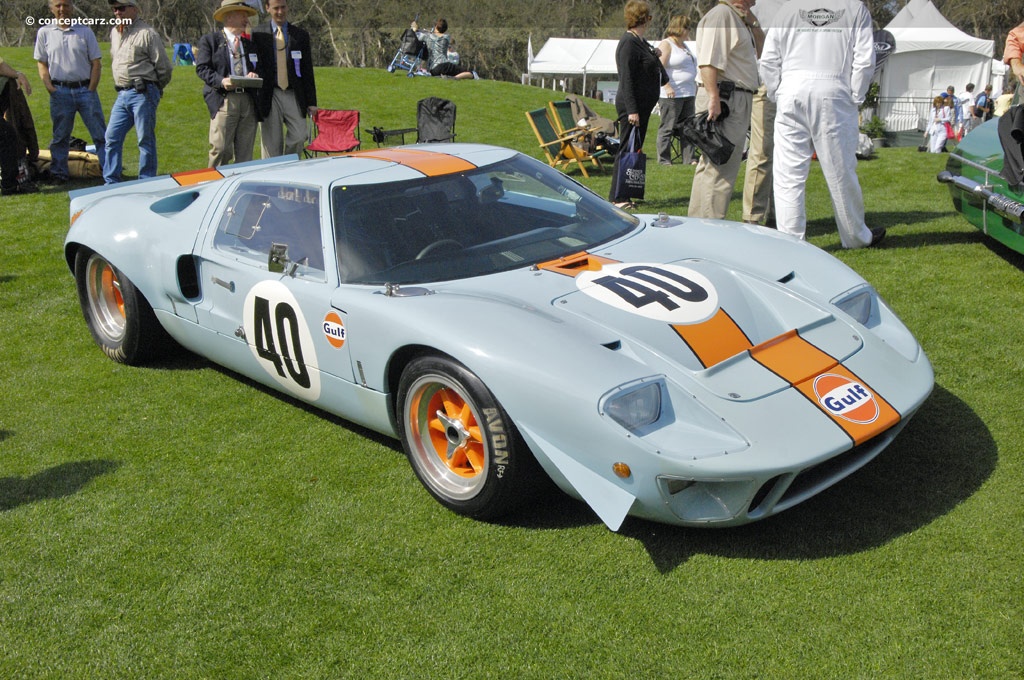
Gulf/Mirage Lightweight
Chassis #: P/1074 (M.10003)
View info and history
Auction entries : 1
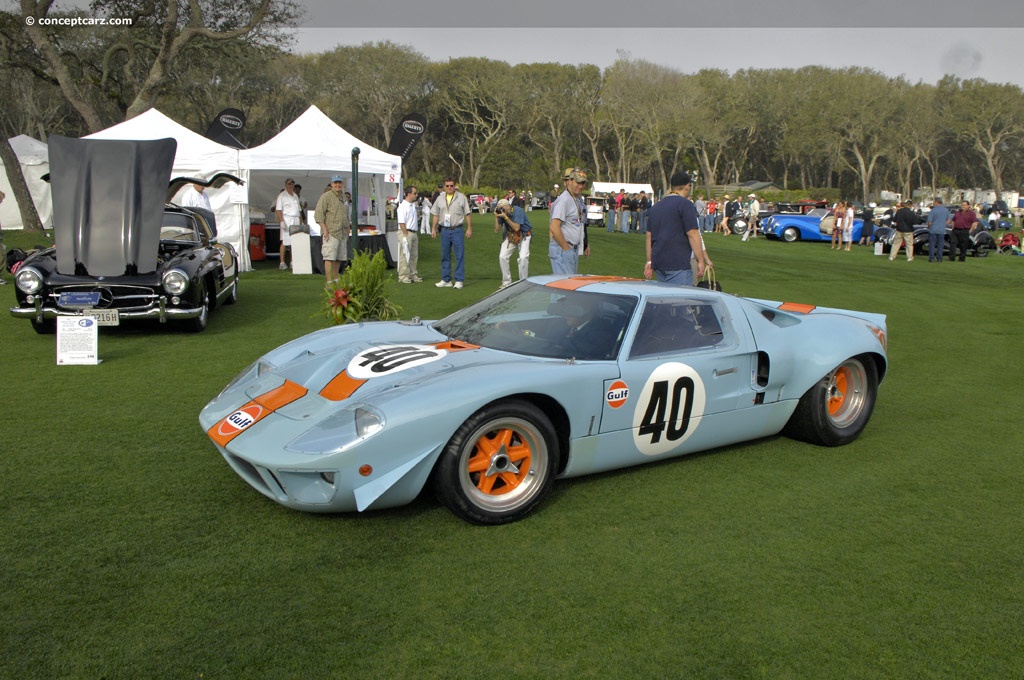
Gulf/Mirage Lightweight
Chassis #: P/1074 (M.10003)
View info and history
Auction entries : 1

Gulf/Mirage Lightweight
Chassis #: P/1074 (M.10003)
View info and history
Auction entries : 1
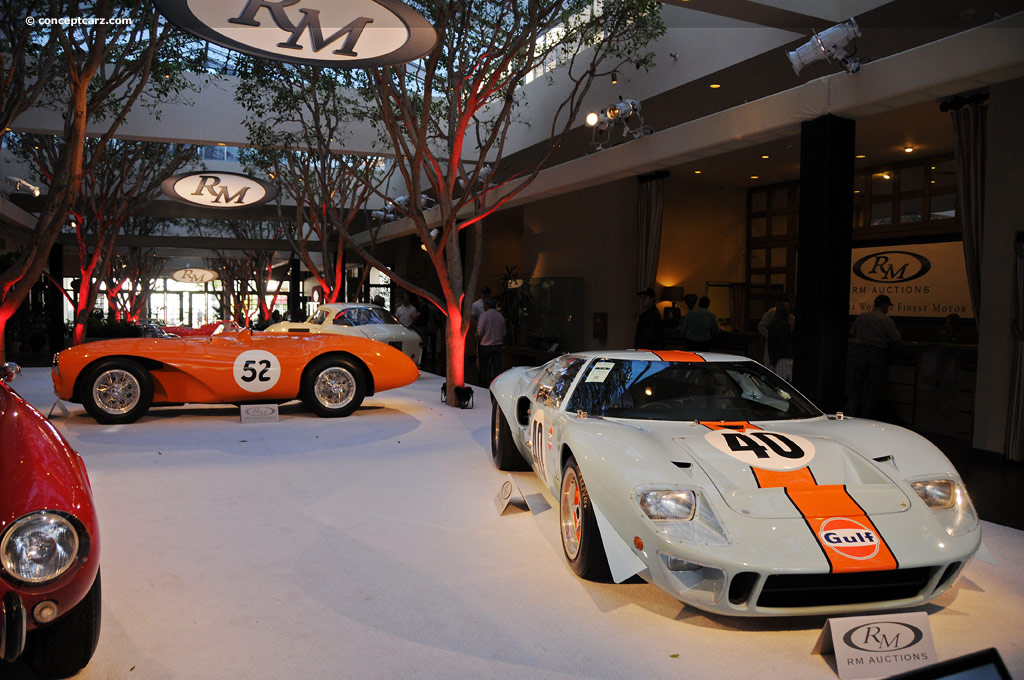
Gulf/Mirage Lightweight
Chassis #: P/1074 (M.10003)
View info and history
Auction entries : 1

Competition Coupe
Chassis #: P/1075
View info and history
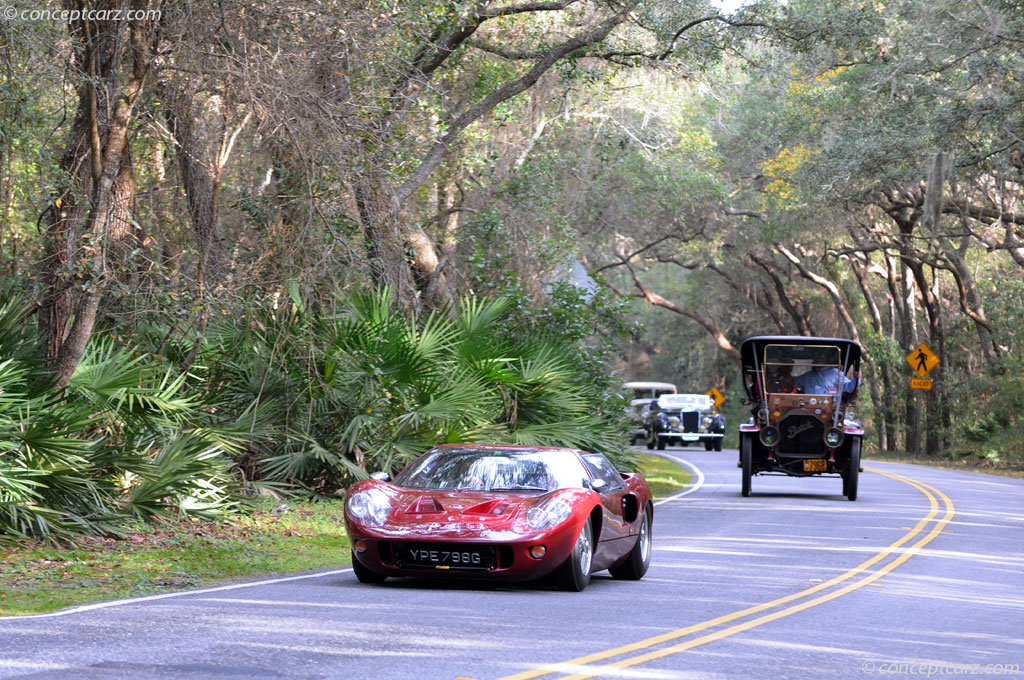
Coupe
Chassis #: 1103
View info and history
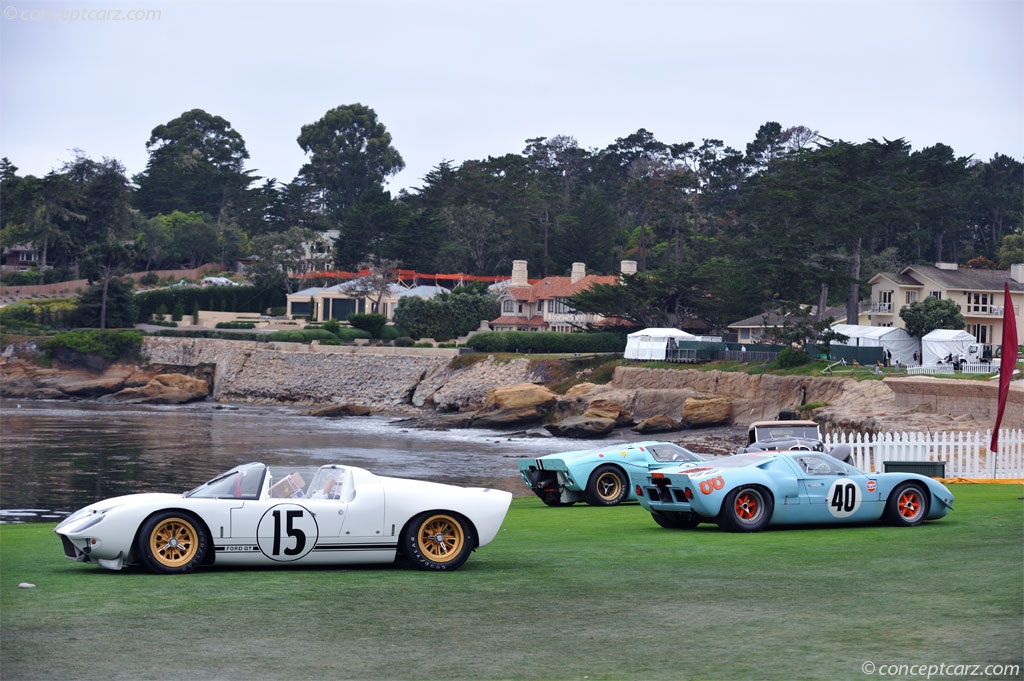
Gulf/Mirage Lightweight
Chassis #: P/1074 (M.10003)
View info and history
Auction entries : 1
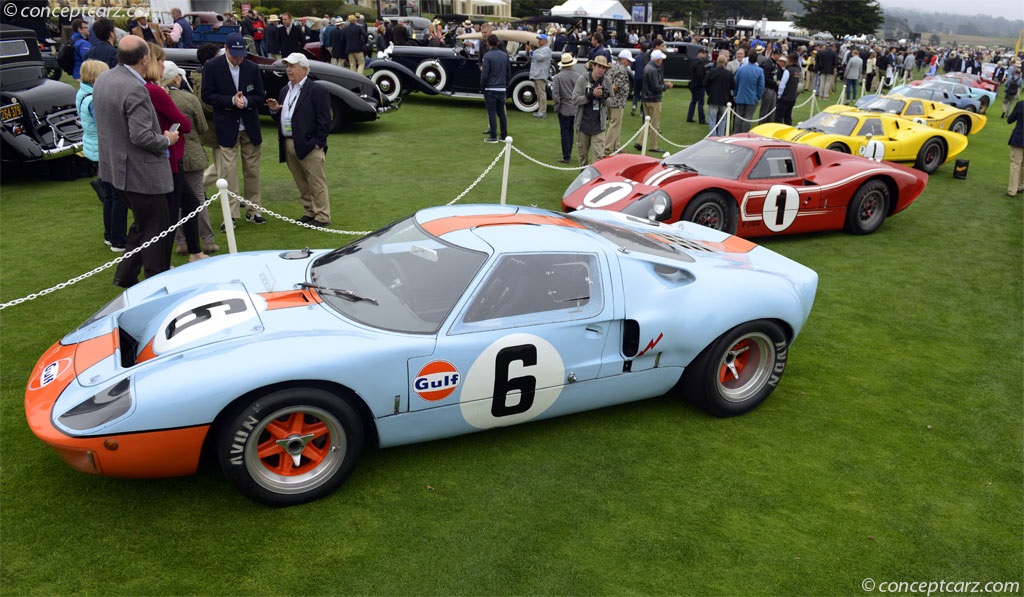
Competition Coupe
Chassis #: P/1075
View info and history
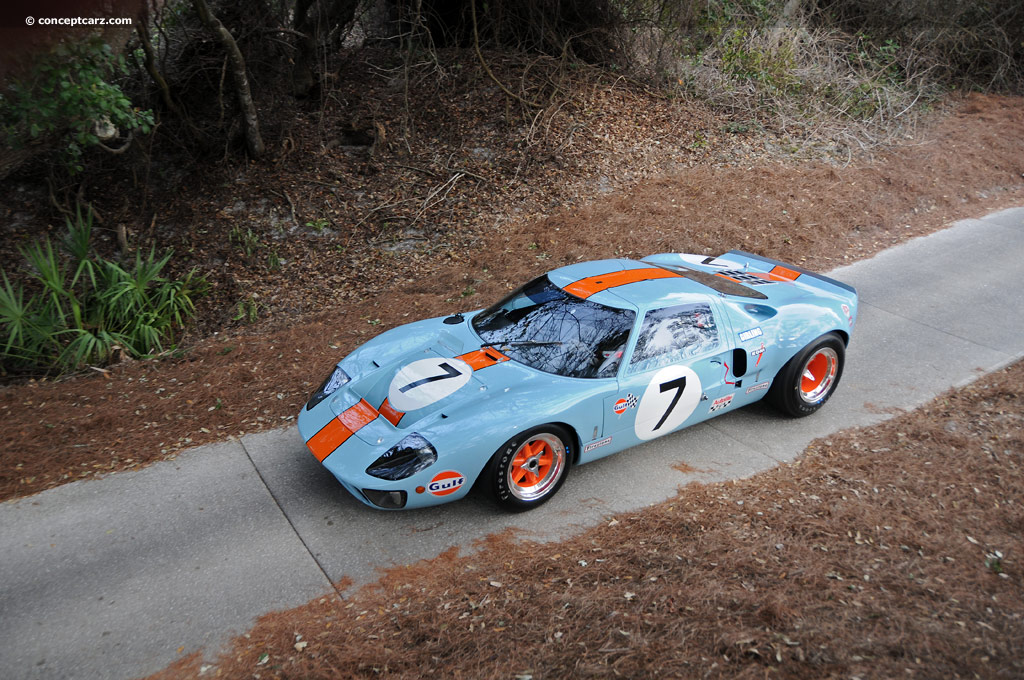
Competition Coupe
Chassis #: 1076
View info and history
The earliest prototypes were powered by a 255 cubic-inch all-alloy V8 engine with the production models receiving 289 CID V8s. Most were built as Coupes, and five prototypes received roadster bodywork, including the Ford X-1. AMGT40/1 and AMGT40/2 were built in 1966 by Alan Mann Racing with lightweight alloy bodies. Most examples of the MKI used the ZF five-speed gearbox. The Slough factory produced 31 examples of the MK I for 'road' use. They were very similar to the racing versions but received wire wheels, a cigarette lighter, carpeting, and fabric map pockets in the door. The X-1 Roadster
The X-1 roadster received an aluminum chassis built at Abbey Panels and a 289 cubic-inch engine. It was later upgraded to MK II specifications with a 427 cubic-inch engine. The X-1 received several gearboxes during its existence, including a Hewland LG500. It was built to race in the 1965 North American Pro Series and entered by Bruce McLaren's team for driver Chris Amon, and later won the 12 Hours of Sebring in 1966. Since the X-1 was built in the United Kingdom, it was liable for tariffs in the United States. Thus, United States customs officials later ordered that it be destroyed.The MK II
The MKII was designed to accommodate the 7.0-liter FE (427 cubic-inch) engine from the Ford Galaxie. Its chassis was similar to the MKI, but modified by Homan & Moody in California to house and handle the larger, heavier and more potent powerplant. It was paired with a new Kar Kraft-built four-speed gearbox. The MK III
The MK III was a road-going car fitted with four headlamps, a detuned 4.7-liter engine offering just over 300 horsepower, and the steering wheel could be installed on the left side. The shift lever was moved to the center, an ashtray was added, and the shock absorbers were softened. Four examples were built with left-hand drive configuration and three with right-hand drive. Most customers seeking a Ford GT40 purchased a MK I that was available from Wyer Ltd, since the bodywork of the MK III was significantly different from the racing models. The J-CarThe J-car was was ultimately a new vehicle designed by Ford's studios and produced by Ford's subsidiary Kar-Kraft under Ed Hull. Its lightweight 'tub' was formed of aluminum honeycomb panels bonded together and built in collaboration with the Brunswick Aircraft Corporation. The overall weight of 2,600 pounds was 300 pounds less than the MK II, thanks in part to its tub which weighed a mere 86 pounds. The chassis, in theory, was rigid, but during a test at Riverside International Raceway in August of 1966 with Ken Miles driving, it shattered upon impact. The accident and the ensuing fire claimed the life of Miles. The cause of the accident was blamed on the vehicle's aerodynamics and a lack of a spoiler. Subsequent development of the J-Car, specifically with more aerodynamic bodywork, resulted in the creation of the MK IV. Of the nine J-car chassis built, six were designed as Mk IVs and one as the G7A. The Mk IV (a.k.a Ford MK IV)
While the MK I through MK III cars were built in England, the MK IVs were constructed in the United States by Kar Kraft. Their chassis was a reinforced version of the J-car and equipped with the same 7.0-liter engine as the MK II. A NASCAR-style steel-tube roll cage was installed for safety purposes but its additional weight negated most of the weight-saving features of the honeycomb-panel construction. Although these were completely different from other GT40s, they did incorporate some of the same mechanical components including the brakes, gearbox, and suspension. A two-speed automatic gearbox was tested but later exchanged with a four-speed from the MK II. The streamlined bodywork helped it achieve 212 mph on the Mulsanne Straight.The Ford GT40 holds the distinction of being Dearborn's first and most important purpose-built sports-racing model, achieving four consecutive wins at the 24 Hours of Le Mans.
by Daniel Vaughan | May 2022
Related Reading : Ford GT40 History
The history of the Ford GT40 began as an attempt to beat a certain Italian Automobile Manufacturer at the grueling 24 Hours of LeMans race. Each June, some of the worlds best in the automotive industry descend onto a town West of Paris called LeMans, France to compete in a 24-Hour endurance competition. This tradition began in 1923 and since has become the pinnacle of automotive racing that challenges....
Continue Reading >>
Continue Reading >>
Similar Vehicles
Similarly Sized Vehicles
from 1968
1968 Ford GT40 Vehicle Profiles
Recent Vehicle Additions
Performance and Specification Comparison
Price Comparison
$2,194
$2,455 - $3,030
$2,600 - $2,812
$2,685 - $3,120
$2,865 - $3,320
$4,715 - $4,925
GT40 MK IV Specification Comparison by Year
Year
Production
Wheelbase
Engine
Prices
Related Automotive News

Can-Am History Roars Back to Life at Spring Classic May 19-21
The Can-Am Series made its last appearance at Mazda Raceway Laguna Seca at the 1973 Monterey Grand Prix. Vic Elford (10) in the UOP Shadow was chased through the Corkscrew by winner Mark Donohue (6) in the dominant Sunoco Porsche 91730.
MONTEREY,...

JOHN SURTEES CBE ANNOUNCES AUCTION LOTS FOR THE 2016 HENRY SURTEES FOUNDATION TEAM KARTING CHALLENGE
Tuesday 5 July 2016 – Mercedes-Benz World Circuit, Brooklands
Team entries are shaping up well for the hotly contested Henry Surtees Foundation Team Karting Challenge, which will take place on Tuesday 5 July 2016. The event organised by John S...

1969 24 Hours of Le Mans: A Traditional Statement Provides a Memorable Race
What if a statement ended up costing one of the biggest victories of ones career Would it be worth it Jacky Ickx would come close to finding out as he approached the checkered flag on the afternoon of the 15th of June in 1969.
Ford had determined...
RRDC VOTES IN 37 NEW MEMBERS FOR 2013
HILLIARD, Ohio (Nov. 7, 2013) - Thirty-seven race-car drivers and motorsports professionals have been voted into the Road Racing Drivers Club in 2013. The group includes 13 Regular Members from the open-wheel and sports-car racing ranks, 20 Associate...

1965 24 Hours of Le Mans: A Cool Head in the Face of a New Threat
Heading into the 1965 24 Hours of Le Mans it had become clear Ford was intent on taking the fight to Ferrari. Ford would spare no expense to take the fight to the company it had intended to buy. Ironically, the North American Racing Team would enter...

























